I’m back with a long overdue selection of some of my favourite Warner Bros cartoons from the Golden Age of Animation. This post will feature several Looney Tunes and Merrie Melodies from 1937-1949, from some of the greatest animators of the Golden Age, like Chuck Jones, Bob Clampett and Tex Avery. As always, lots of videos, pictures and inappropriate captions! All highly original content.
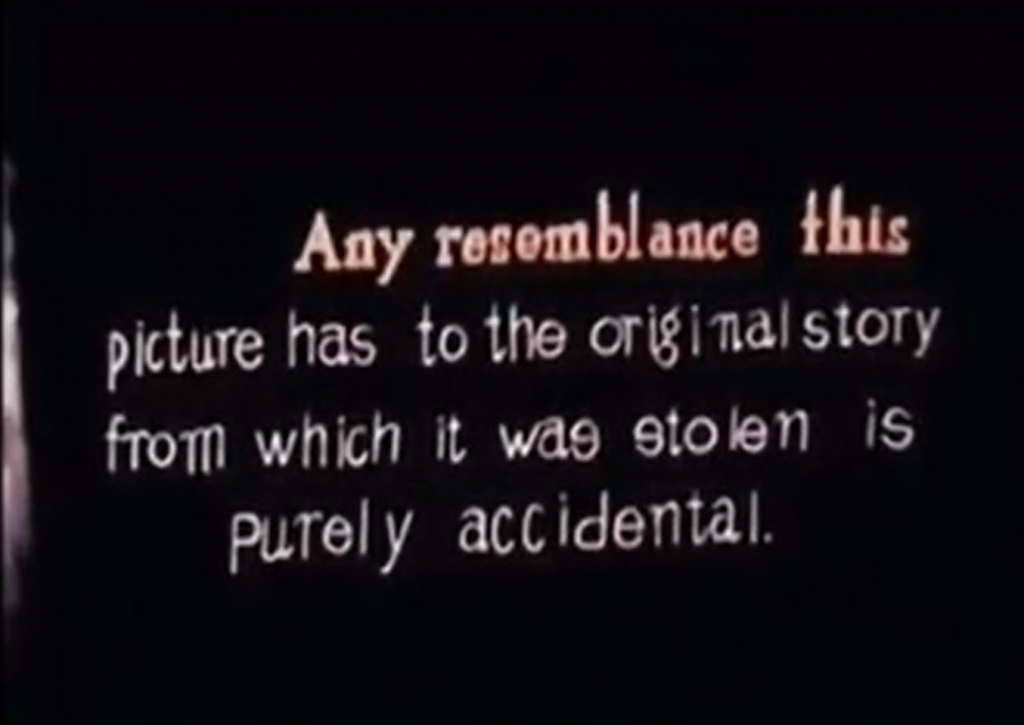
In the mid 30’s, Schlesinger hired director Tex Avery to revitalize the studio. Avery realized there was no point in competing with Disney. Instead he focused on wacky comedy and looney characters and found Warner Bros. cartoon’s place in the animation market. Around 1935 Porky Pig had made his first appearance. And in 1937, the golden boy of Warner Bros cartoons at the time, Bob Clampett, created Daffy Duck. Clampett is now known as one of the most influential animators of this age, with his trademark surrealistic, energetic and outrageous animation. He is lauded for putting the word ‘looney’ in Looney Tunes. Eventually he took over the Termite Terrace as people call it, while Tex Avery took over the Merrie Melodies. The Looney Tunes and Merrie Melodies had been going for a while, but produced no more than a few promising moments here (Page Miss Glory) and there (Porky’s Badtime Story) and there (Porky’s Railroad). It was only when much more of these famous characters stepped on the screen something special happened. It took a while for the animators to get them just right. By 1939, they seemed to have figured it out. Check out Bugs Bunny’s debut below. We start where we left off, in 1937, when Warner Bros cartoons was still called Leon Schlesiner productions, right after the release of Snow White.
Leon Schlesinger Productions cartoons
1937-1938
Looney Tunes – Porky’s Duck Hunt 1937
First official appearance of a certain duck. Clampett elaborated on his exit at the end screen, thus opening up the opportunity for more of Daffy Duck in the future.
Looney Tunes – Daffy Duck & Egghead, 1938
Daffy’s actual introduction came a bit later. This one features his old signature crazy laugh. Bit scary actually. Also check out Egghead killing an audience member.
Looney Tunes- Porky’s Hare Hunt, 1938
Prototype of a barely recognizable Bugs Bunny.
Looney Tunes – Porky in Wackyland, 1938
A Bob Clampett cartoon. A bizarre, surreal acid trip. Hidden gem rating? Sure I’m still doing that.
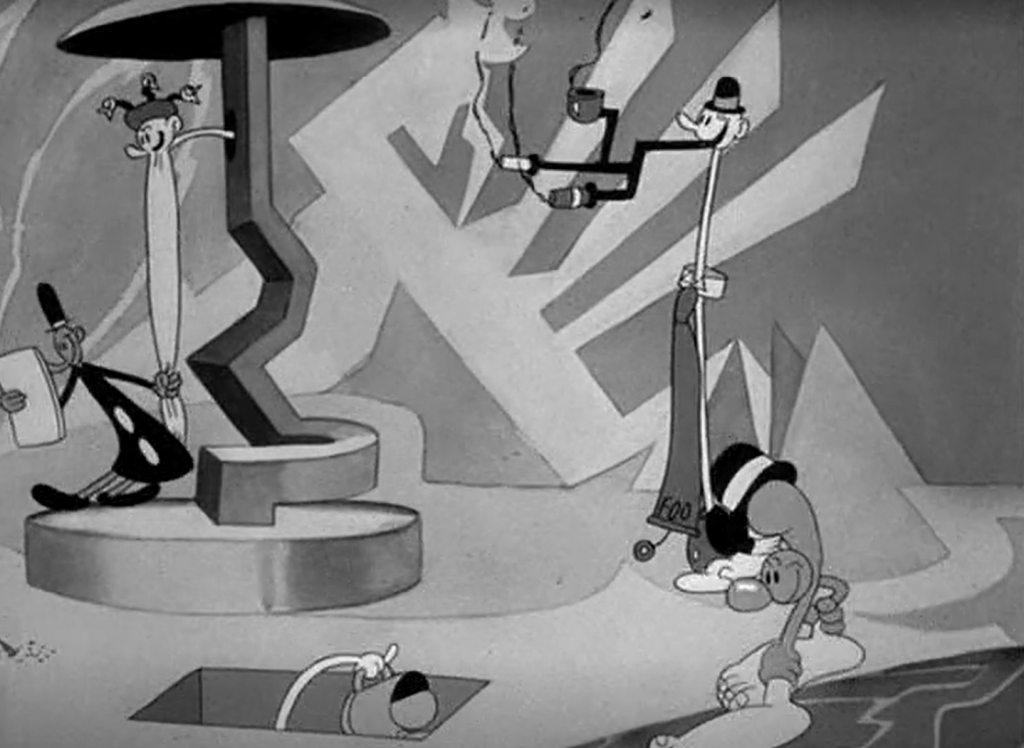
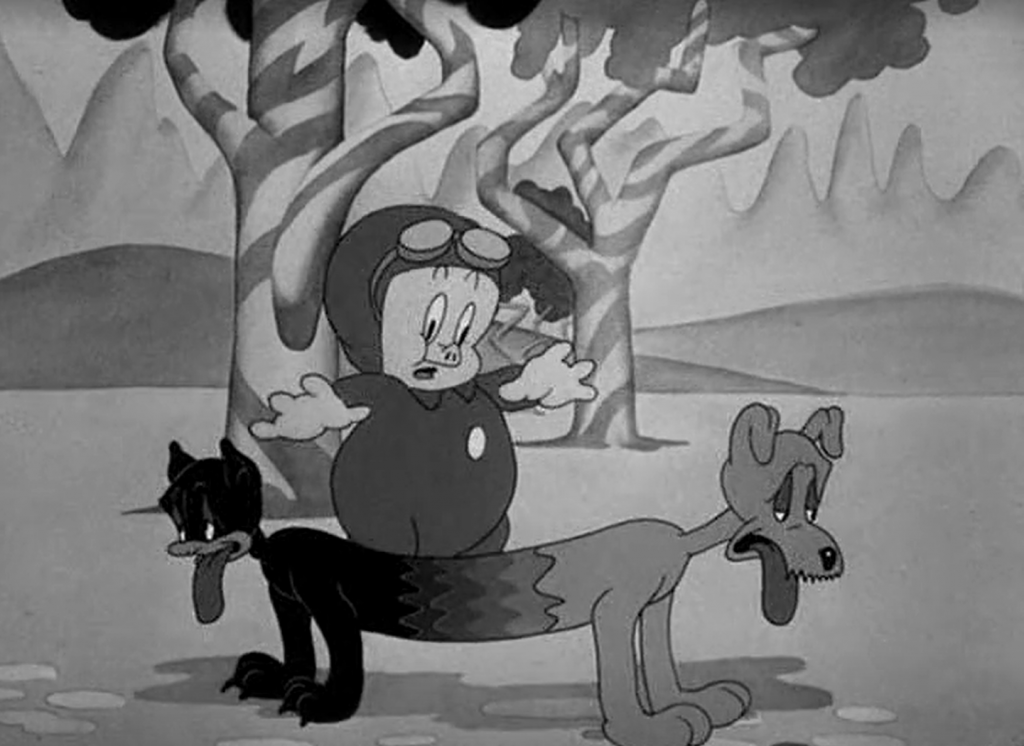
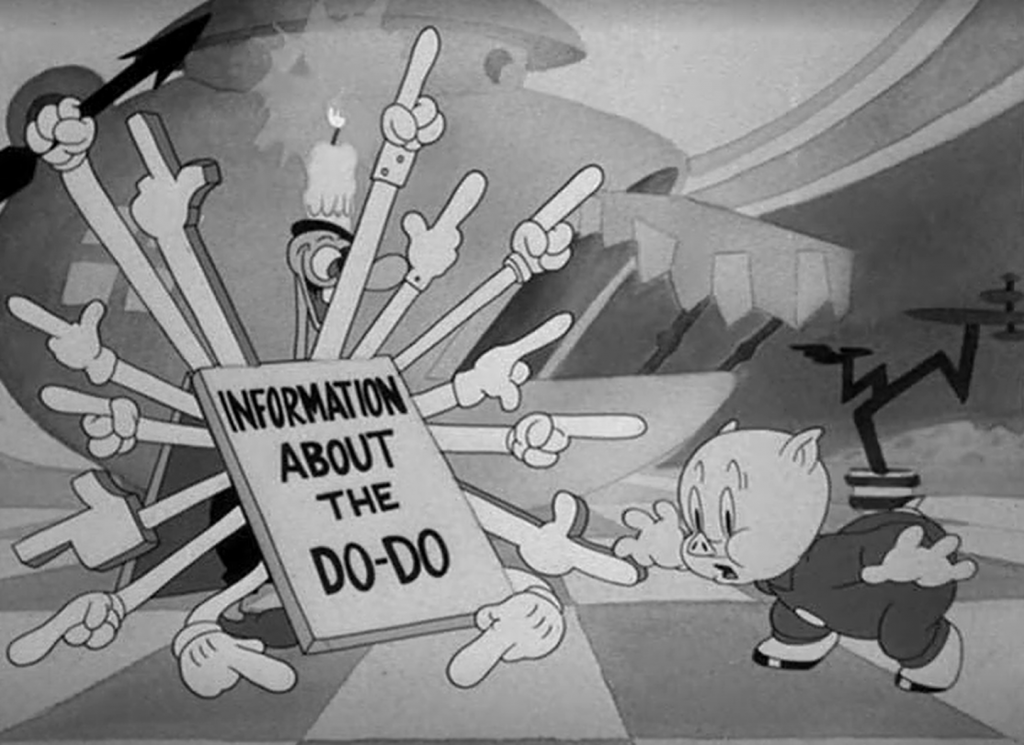
1939
Daffy Duck and the Dinosaur, 1939
By Chuck Jones. High speed chases and rapidly spinning backgrounds (not as impressive as it sounds). Daffy’s a bit less insane. The animation department is improving rapidly though. This “rapidly” was better deserved.
Merrie Melodies – Thugs with Dirty Mugs, 1939
Tex Avery lets loose some of his creativity. There’s the cool shot from the air at 0:50 or the newspapers connecting the sequences at several instances and telling the story. (Actually the newspaper thing isn’t all that original as an introduction to a scene, but here it really ties the story together.) Or this split shot below. And that’s not the only time they break the fourth wall in this cartoon.
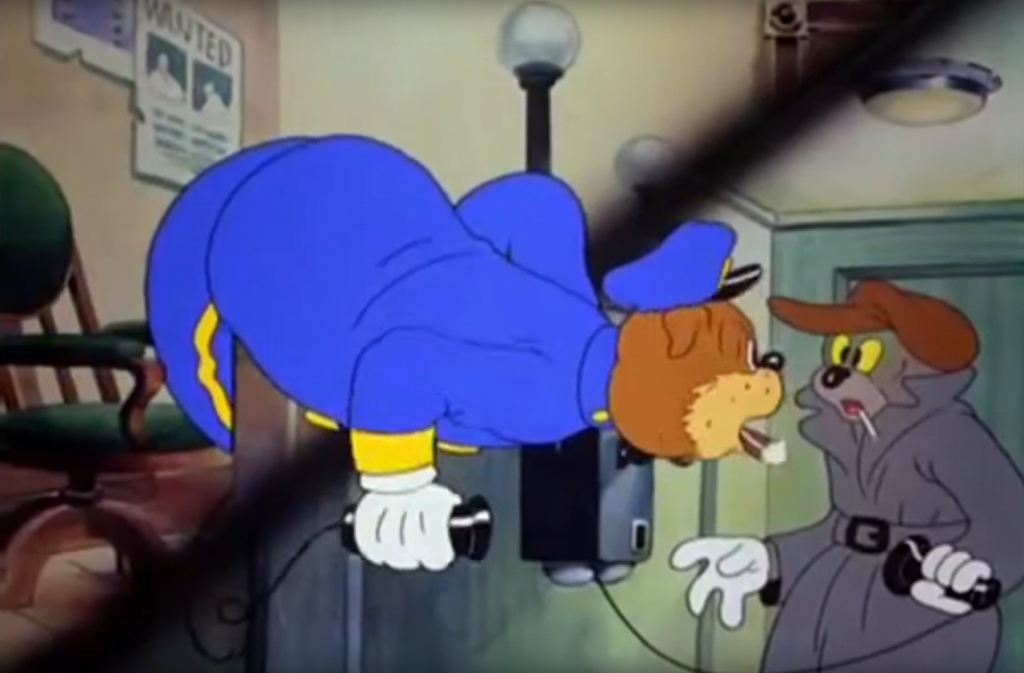
1940
Looney Tunes – Porky’s Poor Fish, 1940
Moderately weird Clampett.
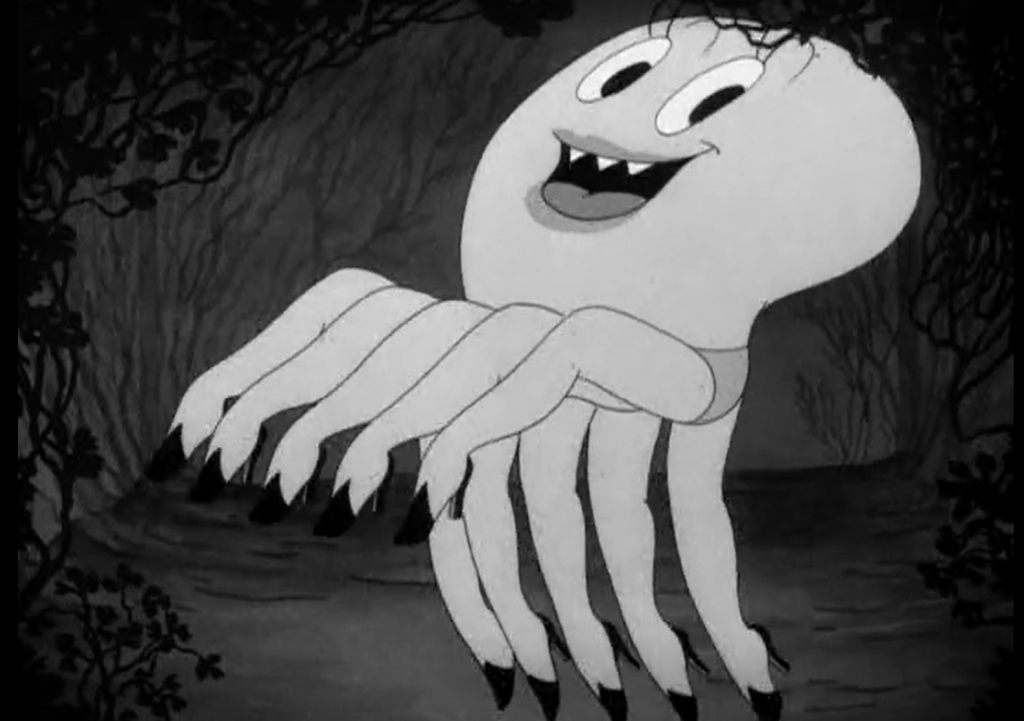
Merrie Melodies – Sniffles Takes a Trip, 1940
Chuck Jones flaunts his style in this pastoral short. Some nice art.
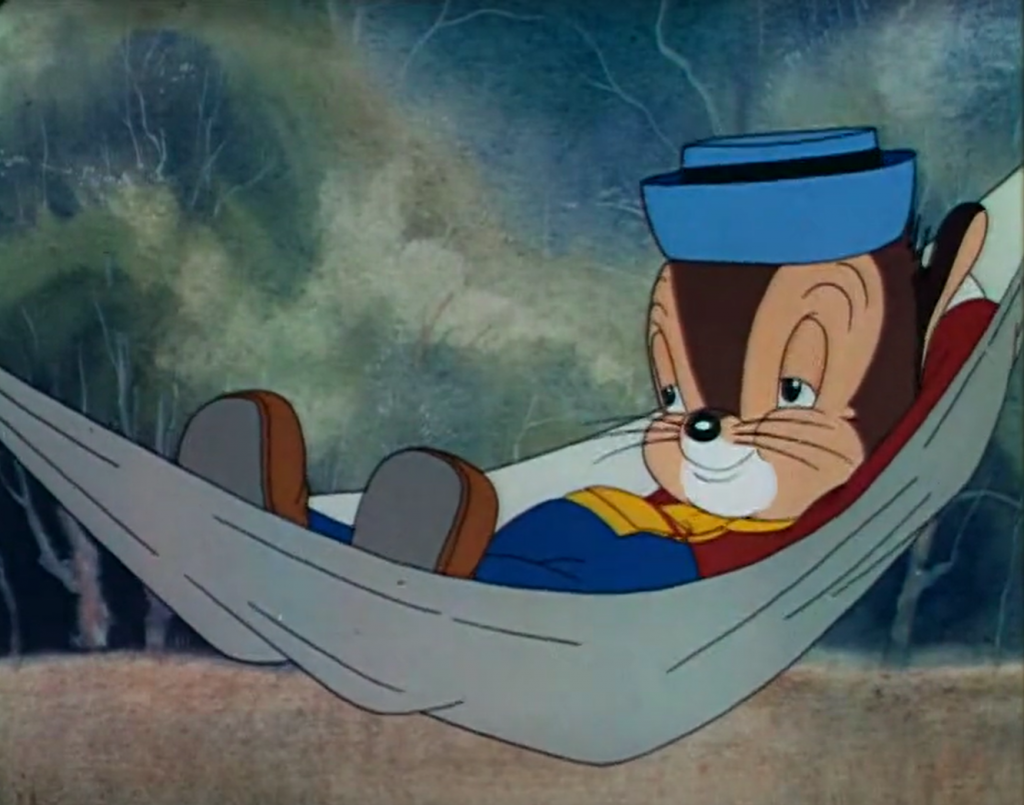
Merrie Melodies – A Gander at Mother Goose, 1940
Collection of parodies on known tales. Amazing animation on the human characters. (See first clip.) I’m always confused when I see these Merrie Melodies or Looney Tunes from around this time that are a 100 times better made than others. This is one of those exceptional ones. And they had to design characters and backgrounds for every single short clip too.
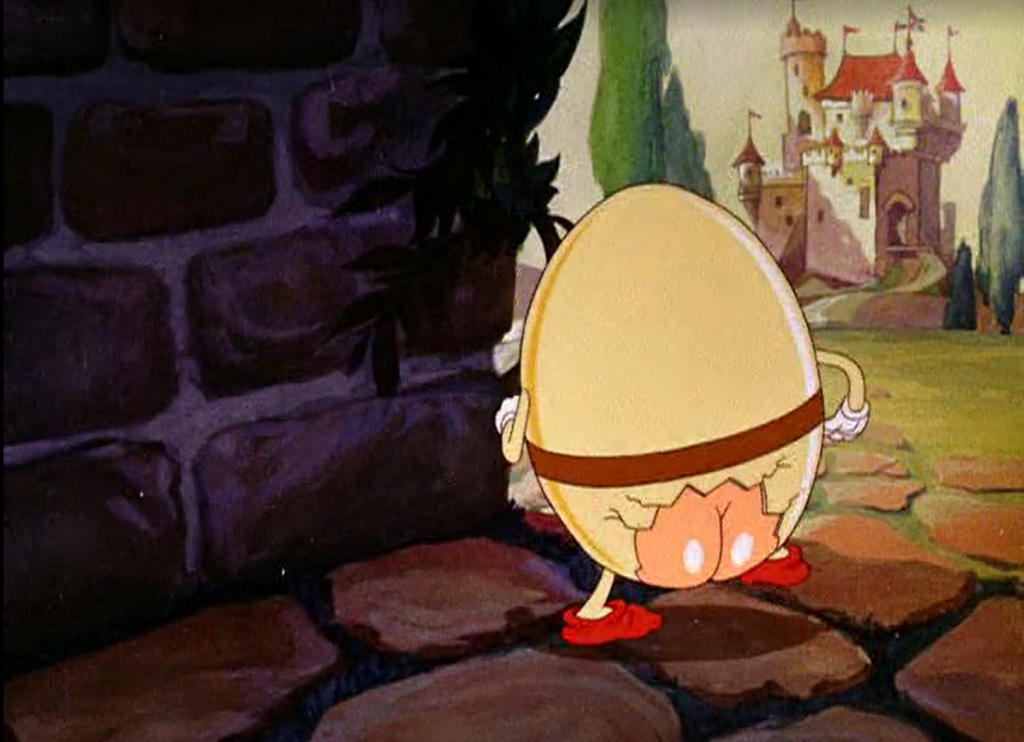
Merrie Melodies – Tom Thumb in Trouble, 1940
It seems like the Schlesinger studio upped their game after the release of Pinocchio. Quality cartoon, great story.
Looney Tunes – A Wild Hare, 1940
I can’t find a full clip, but I’m sure you’ve seen it. This is not only the debut of Bugs Bunny, A Wild Hare is the short where the voice and appearance of Elmer Fudd was settled on. Note the way both Elmer Fudd and Bugs Bunny speak and move. I can only imagine what effort the animators must have gone through to make these anthropomorphic characters walk and talk the way they envisioned. Stop yawning, this is interesting stuff. Bugs’ nonchalant stance was based on Clark Gable in It Happened One Night, giving instructions with his mouth full of carrots. This was a very famous scene in 1940, so the audience immediately made the connection.
Looney tunes- Prehistoric Porky, 1940
Just compare this to other Porky’s from the same year, that weren’t by Clampett.
1941
Looney tunes – Porky’s Preview, 1941
I’m gonna go out on a limb here and assume that during the war, because of reduced income, animators got creative in dealing with limited resources? Even Disney reused old footage and occasionally resorted to repetitive movements. In this one the Looney Tunes animators seem completely stripes bare. The concept is a movie drawn by a child, which basically gives them an excuse to draw stick figures on a white background. Kind of cool though.
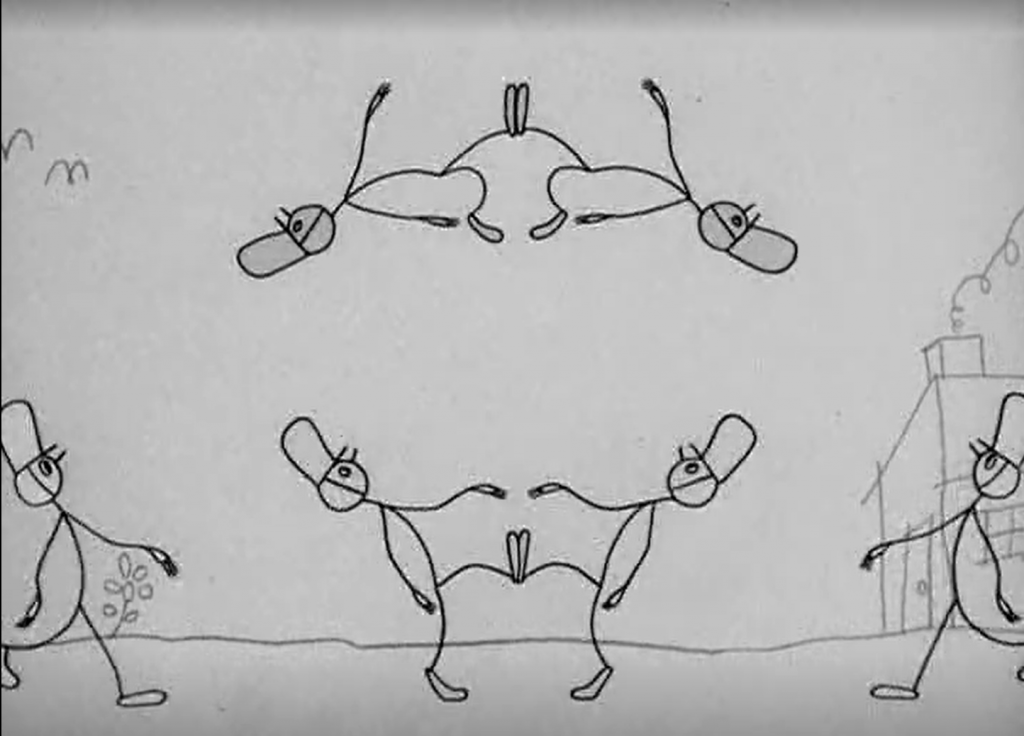
Looney Tunes – The Wacky Wabbit, 1942
+ Fresh Hare, 1942
Bugs Bunny being a provocative d*ck for no good reason. No I don’t mean duck. Here’s one with oddly beautiful backgrounds.
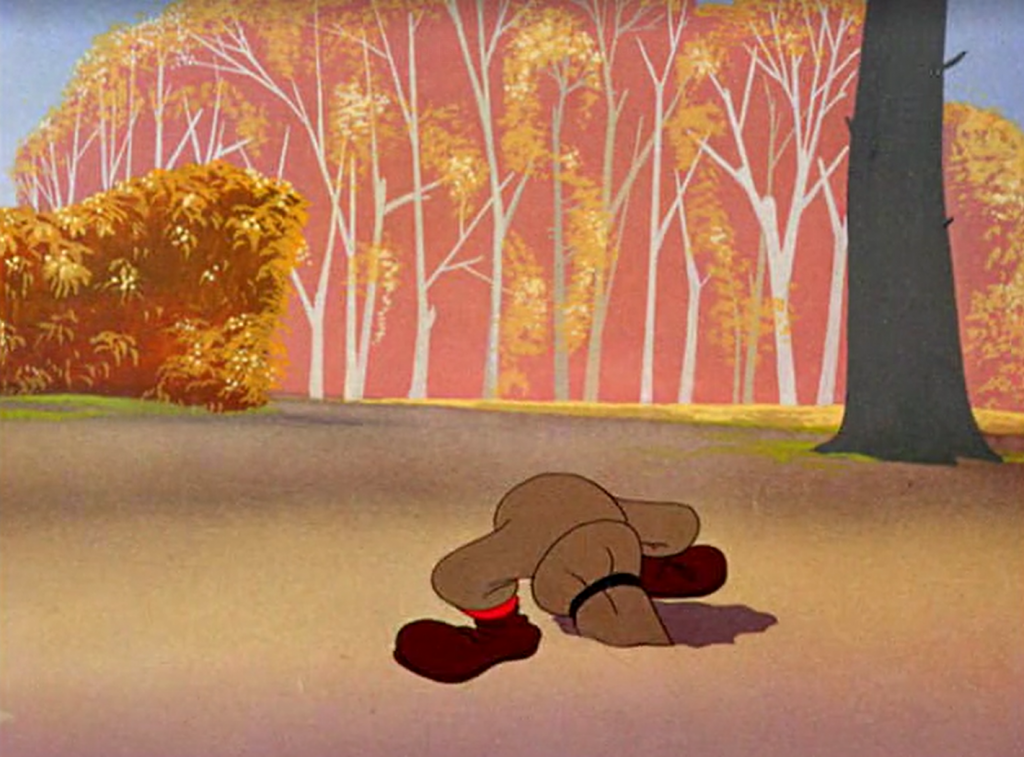
1942
Merrie Melodies – The Dover Boys at Pimento University or The Rivals of Roquefort Hall, 1942
Chuck Jones experimented with a different look and style of animation, focusing on still shapes instead of realistic movement. And if you look closely at the motions of the characters, you can notice an animation technique called the “smear”, which is kind of like a motion blur in a photograph. Am I explained that right? More info on the subject here from someone who did some actual research. Warner Bros actually tried to fire him because of his experimentation. The humor was a lot more subtle than in usual Merrie Melodies. Jones said it was the first cartoon he made, that he actually found funny himself. Below is the smear caught in action.
Hidden Gem rating!
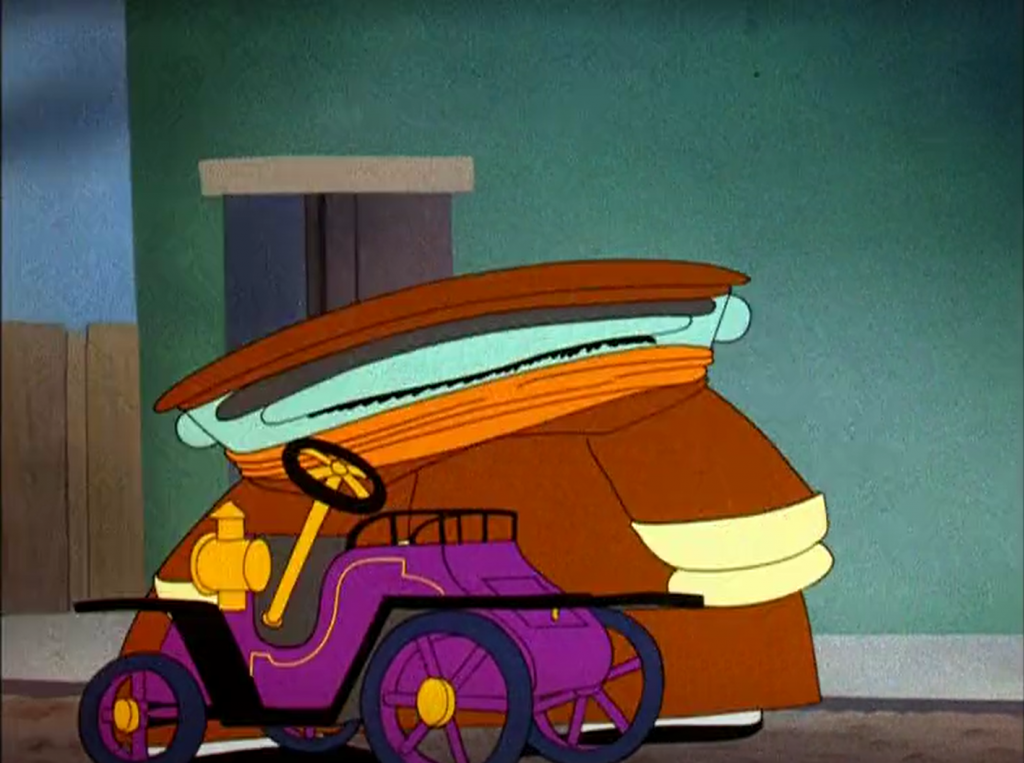
Looney Tunes – the Hep Cat, 1942
The cartoons were getting a bit wilder. This one’s particularly ‘busy”. Clampett’s experimentation was reaching a kind of peak. Bodies are constantly altered and morphed to better illustrate the emotional or physical state of the characters.
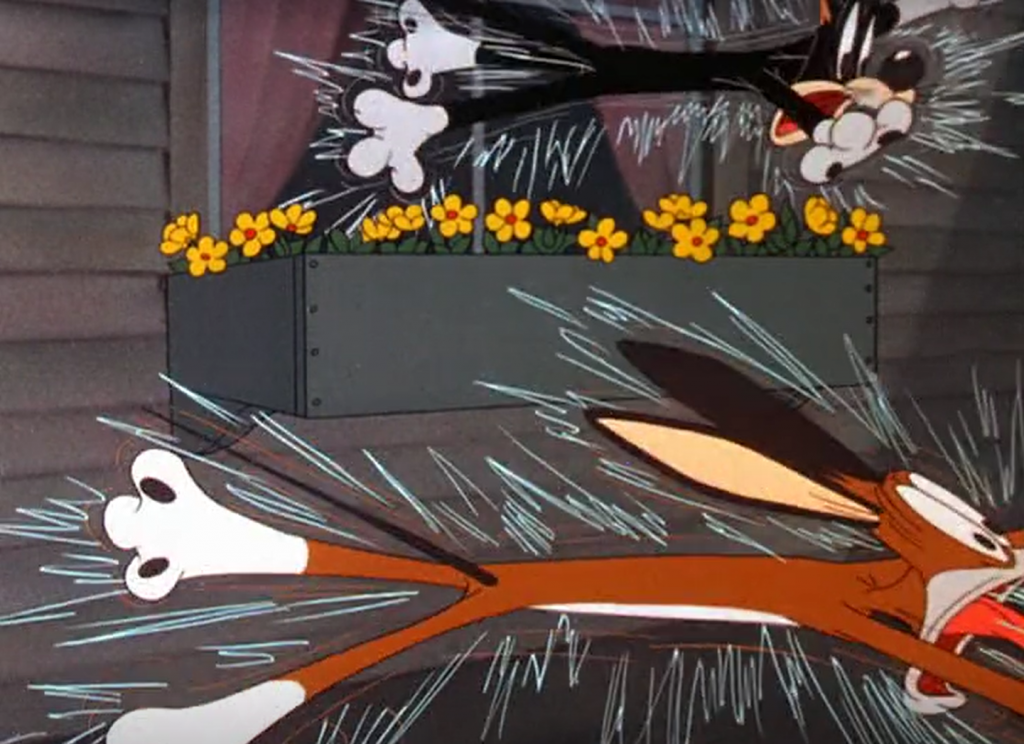
Merrie Melodies – A Tale of Two Kitties, 1942
Debut of Tweety Bird, who is introduced as a cute but violent and sadistic little bastard. This cartoon also features a thinly veiled reference to giving the middle finger to the Hays Office, responsible for the Motion Picture production Code. I doubt “flipping the bird” was even necessary to piss off any censors when the whole cartoon features some of the most evil, murderous behaviors of animated characters to date. Animation high point: Tweety crushing the cat with an anchor, both falling into a hole and taking to whole scenery with them. FOTO Holy murderous f*uck. / “I thought I thaw a puddy cat. Let’s just slowly torture and murder it.” / Tweety slowly murdering someone
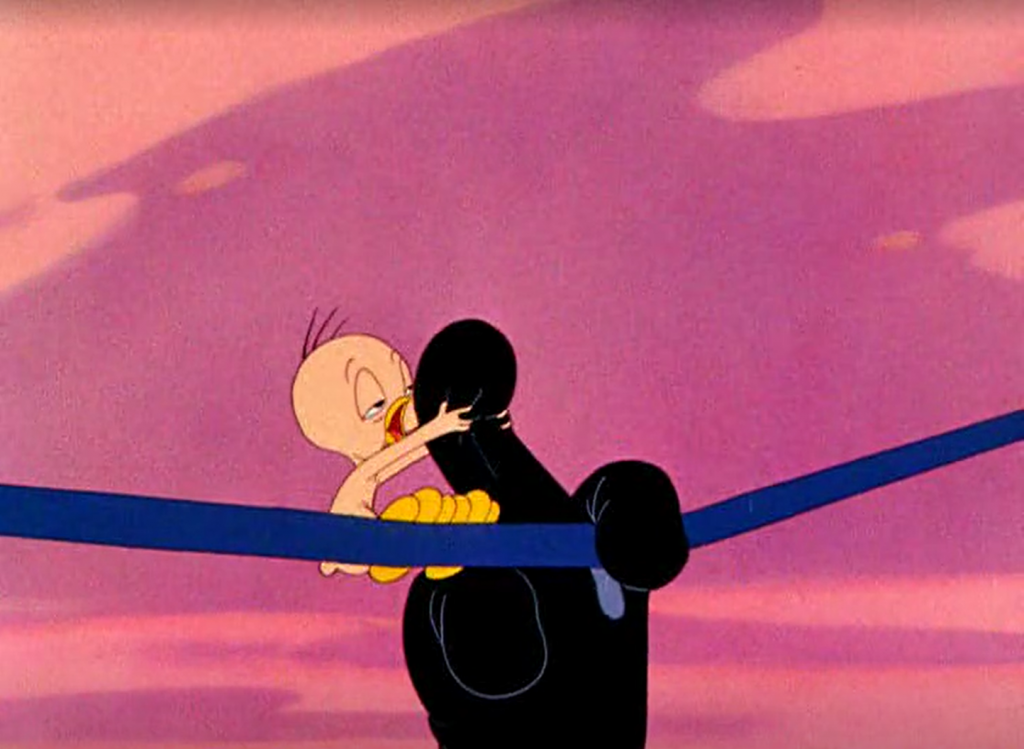
Looney Tunes – My favorite Duck, 1942
Just a funny Daffy and Porky short. May as well have been a Bugs and Elmer one. But these two work well paired together. I’ve never seen Porky with this kind of murderous look in his eyes. The Looney Tunes got a color make over around this time. The producers used this to add a certain distinctive style to the cartoons. In fact the cartoons look a lot more sophisticated now.
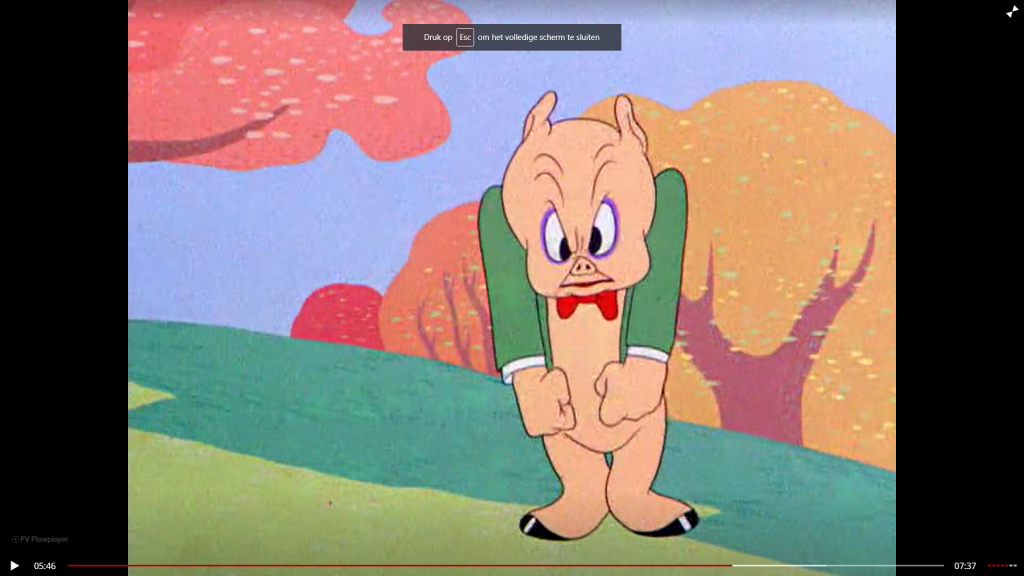
Looney Tunes – Case of the Missing Hare, 1942
Speaking of backgrounds, here they were reduced to patterns and colored cards which gives a kind of surreal, foreign result. I grew up with Pokémon so it’s good enough for me. Could be said to be stage backgrounds.
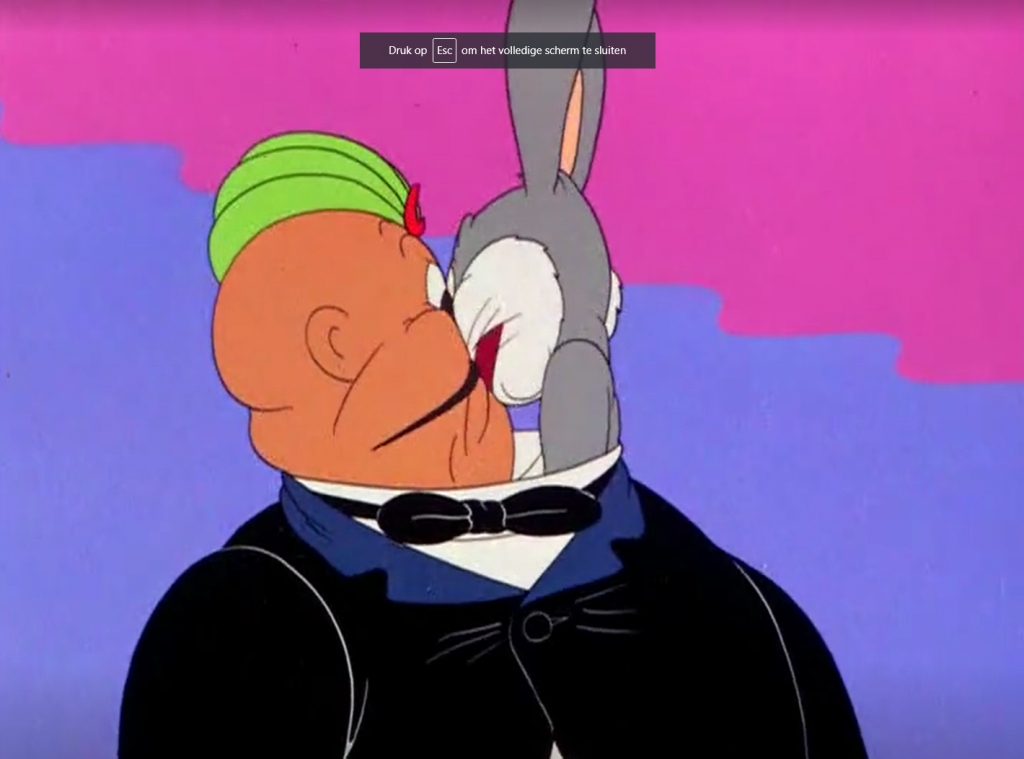
1943
Merrie Melodies – Pigs in a Polka, 1943
A parody of Disney’s Three Little Pïgs and Fantasia.
Merrie Melodies – The Unbearable Bear, 1943
Chuck Jones again with a very stylish noir-like cartoon. Look at that art. It didn’t even pay attention to the characters. What was it about again? Something about bears?
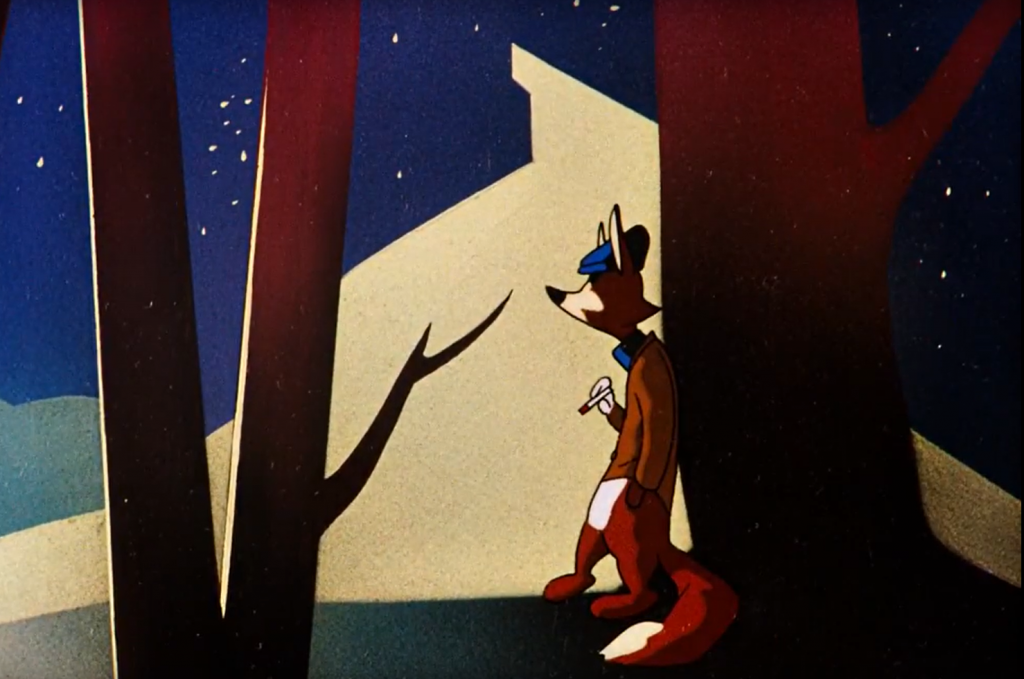
Merrie Melodies – The Aristo-Cat, 1943
I think Chuck Jones was secretly getting high at Termite Terrace. I feel a bit dazed myself, watching his work. Why do all these characters live in such trippy houses? Were they all color blind when they bought them? FOTO
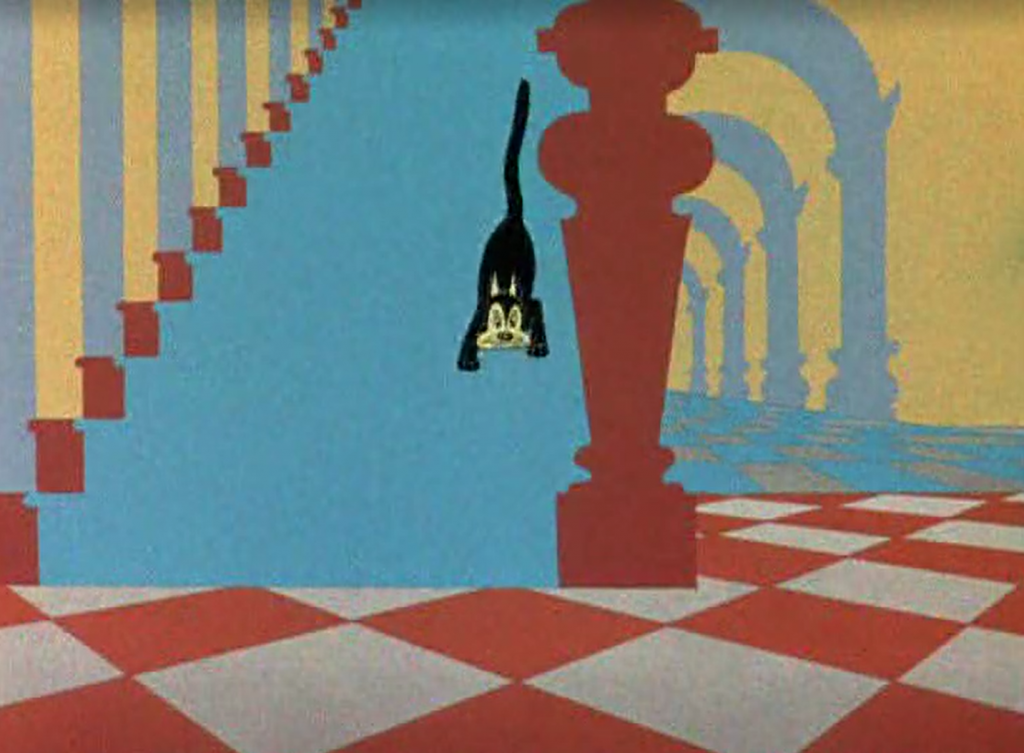
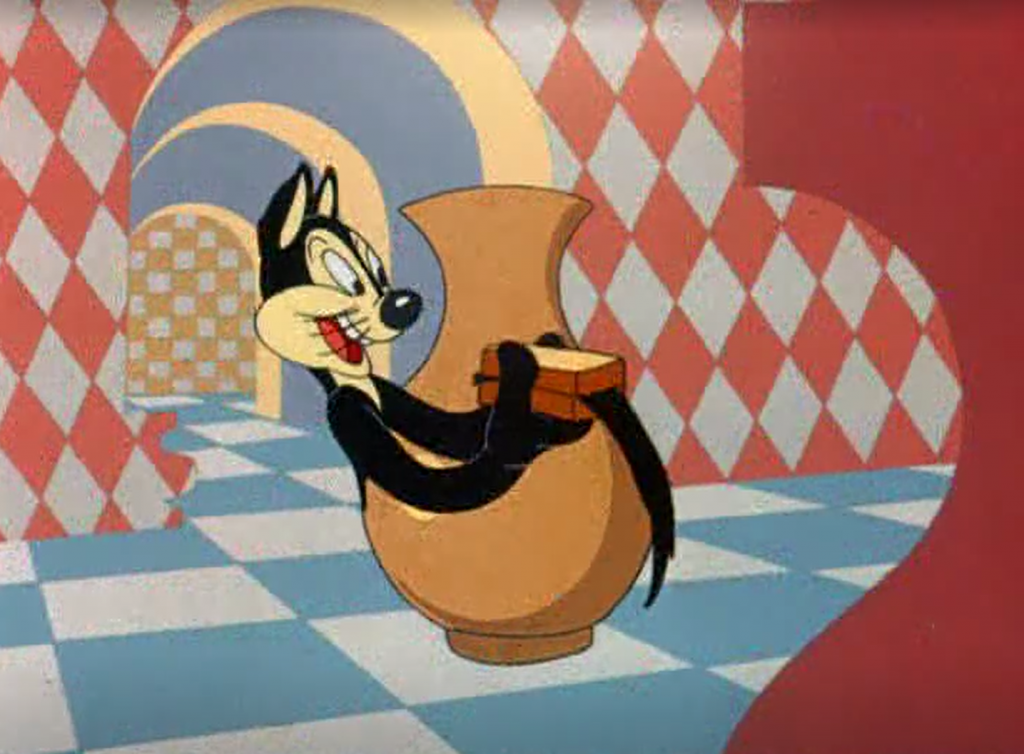
Merrie Melodies – Wackiki Wabbit, 1943
I’m trying to be picky and not make the list too long but every one of these cartoons makes me go “dude, you have to see this!”. If you thought the last one was trippy, this one is pure LSD.
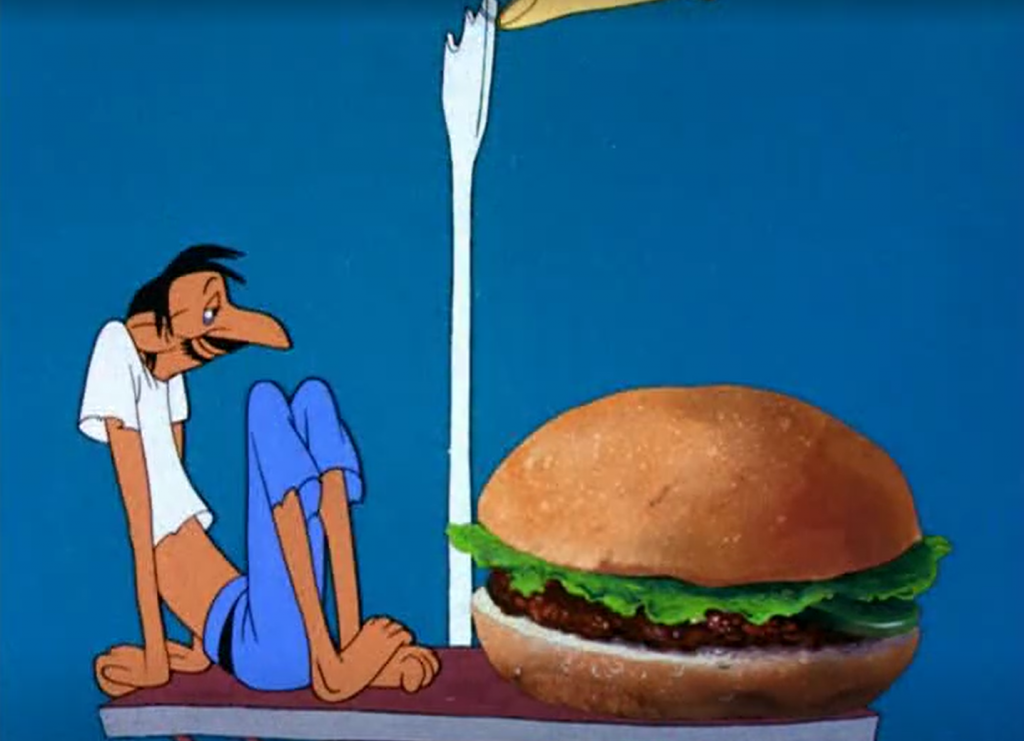
Looney Tunes – Porky’s Pig Feat, 1943
Frank Tashlin returns to the studio from Disney and Screen Gems. Some of my favorite looney moments from Daffy like Daffy shoving his entire head into another dude’s face. There’s the classic running back and forth through loads of doors bit. The “monotonous isn’t it?” sign on the door.
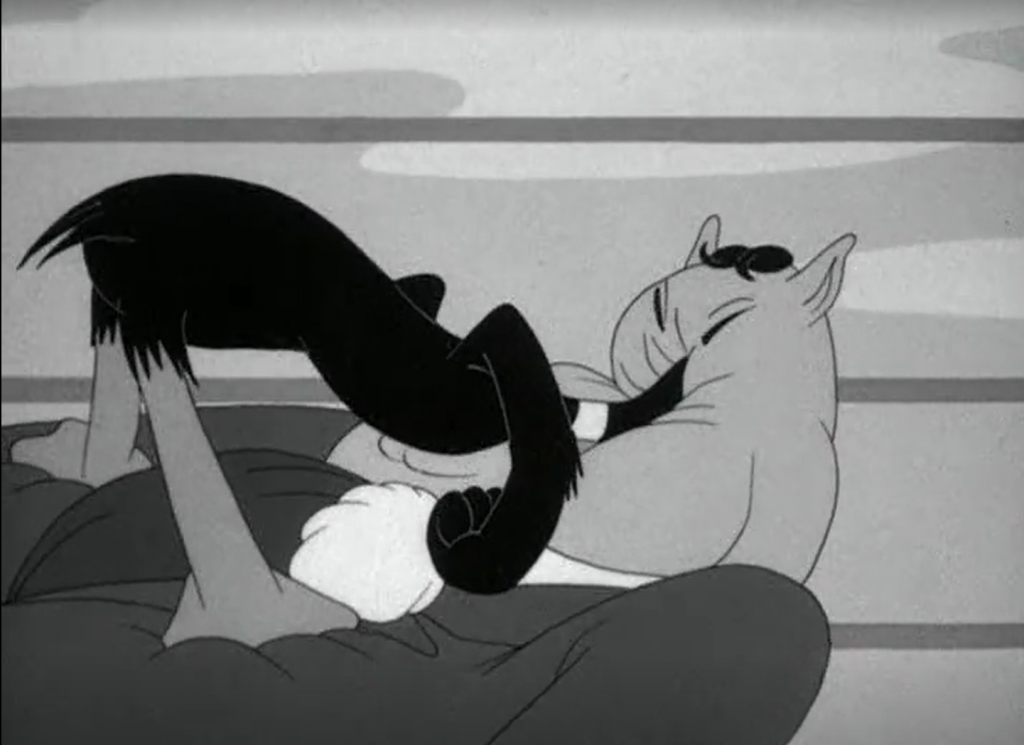
Merrie Melodies – Falling Hare, 1943
Bugs Bunny gets his ass handed to him by a gremlin. Bob Clampett’s approach to Bugs Bunny was to make him be the loser of every cartoon, instead of the other way around. But this one is almost as violent as the one with Tweety Bird.
Merrie Melodies – An Itch in Time, 1943
One of my favorite Clampett cartoons. All the various ways in which the flea inflicts itch and pain on the dog’s skin crack me up.
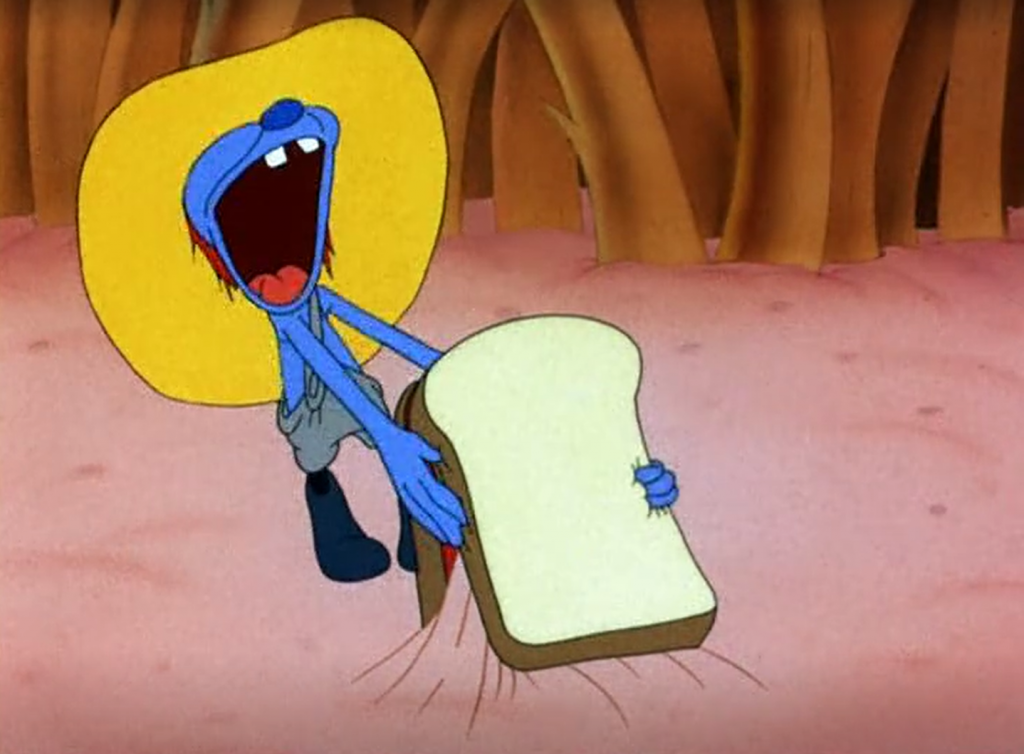
1944
Merrie Melodies – The Weakly Reporter, 1944
A Chuck Jones cartoon satirizing the sacrifices of people on the homefront during the war in a visually stylized way.
Looney Tunes – Swooner Crooner, 1944
Here’s a treat for you. The whole clip is about a bunch of chickens getting horny and ovulating like crazy while listening to some roosters sing and act like Sinatra and other famous artists.
I seem to have included a lot from these couple of years. But with directors like Chuck Jones, Bob Clampett, Frank Tashlin and Isadore Freleng at the height of their ability, and with the rapid development of Bugs, Daffy, Porky and Elmer. It’s no wonder. Just for comparison, this was around the time Disney was struggling. So it was definitely Schlesinger’s time to shine. To close off 1943, here’s a and mouse game featuring a cat and a, uh, bird called Puss ‘n Booty, masterfully directed by Frank Tashlin.
Merrie Melodies – Russian Rhapsody, 1944
Gremlins sabotaging Adolf Hitler’s air plane. I think by now Hitler is as much a recurring character in these cartoons as Bugs or Daffy is.
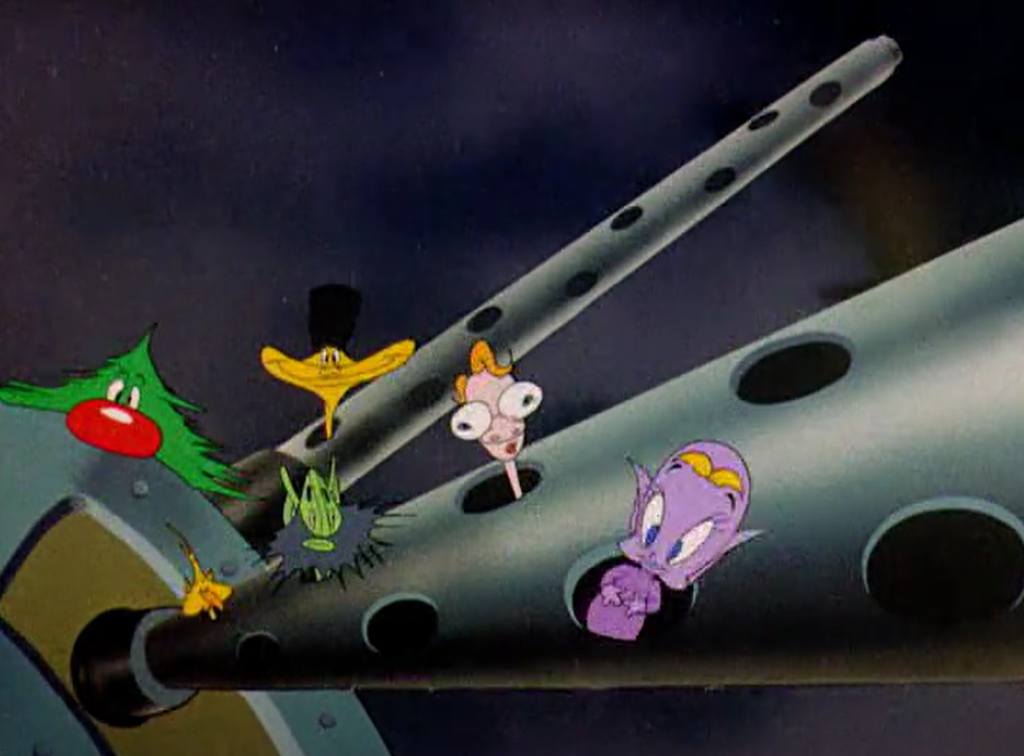
Warner Bros Cartoons
In august 1944, Leon Schlesinger sold his cartoon studio to Warner Bros. Edward Selzer was named the new producer. But you don’t care about all that, here’s some funny animals doing antics.
Looney Tunes – Plane Daffy, 1944
Full of effects and elongated smears. Oddly not by Clampett, but Frank Tashlin. Favorite animation moment: Daffy, fallen for the nazi seductress, melts down the stairs. You heard me. 5:18 is hilarious and absurd too. Actually that whole minute is insanity.
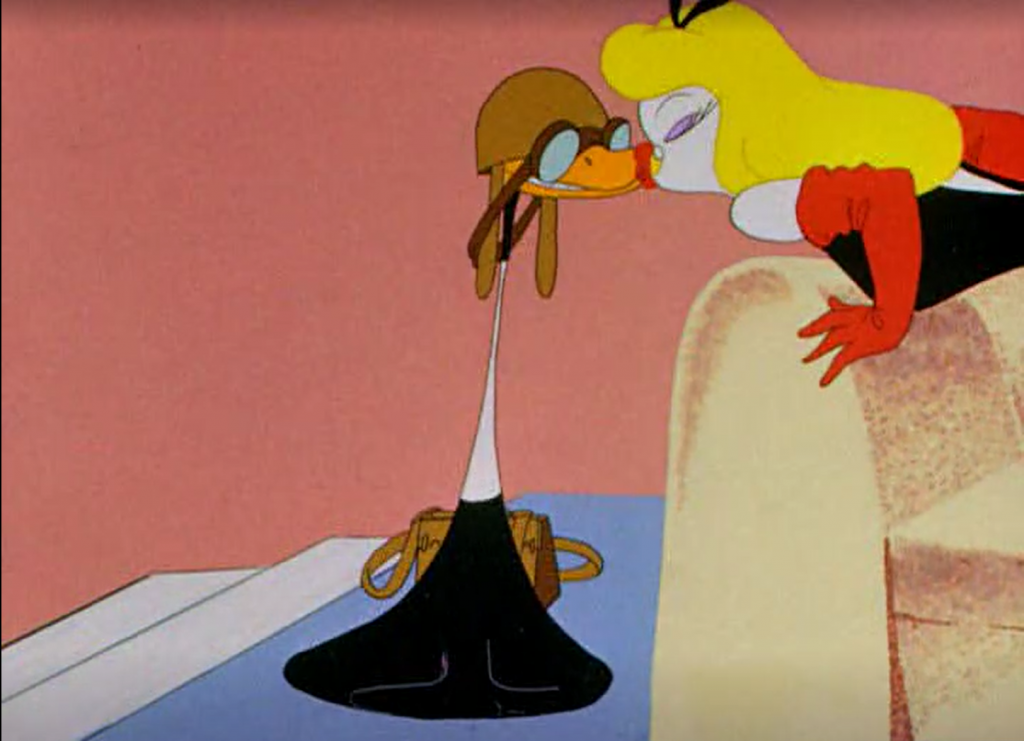
Merrie Melodies – The Old Grey Hare, 1944
Famous one where Elmer and Bugs are old buggers and babies. Attempts to answer the question “will Elmer ever catch Bugs”.
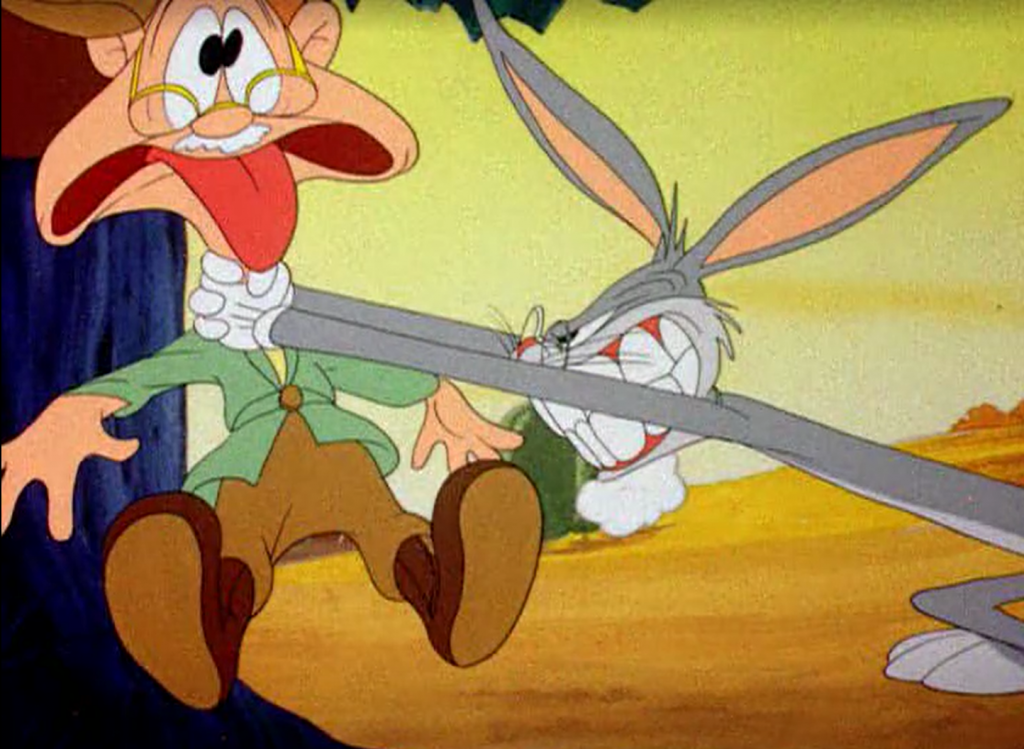
Also interesting to see how people envisioned the future in 1944.
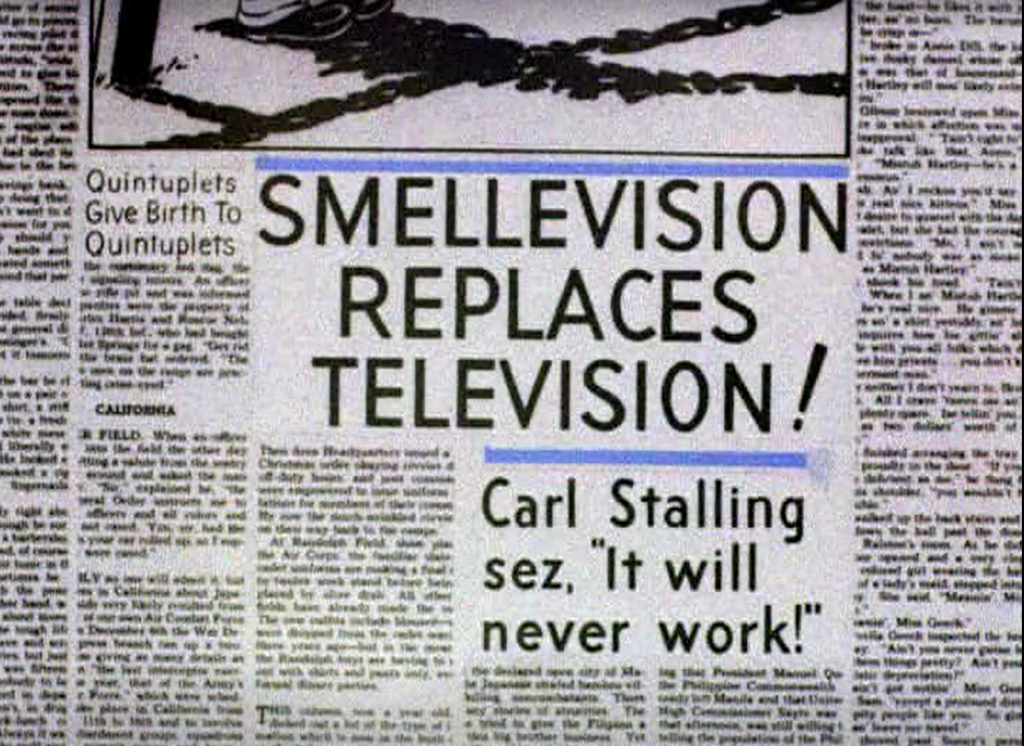
This newspaper is the most sci-fi this cartoon gets though. It’s all more about Elmer and Bugs and their eternal struggle.
Looney Tunes – The Stupid Cupid, 1944
Sometimes Tashlin does Clampett better than Clampett. And Elmer’s laugh has never been scarier.
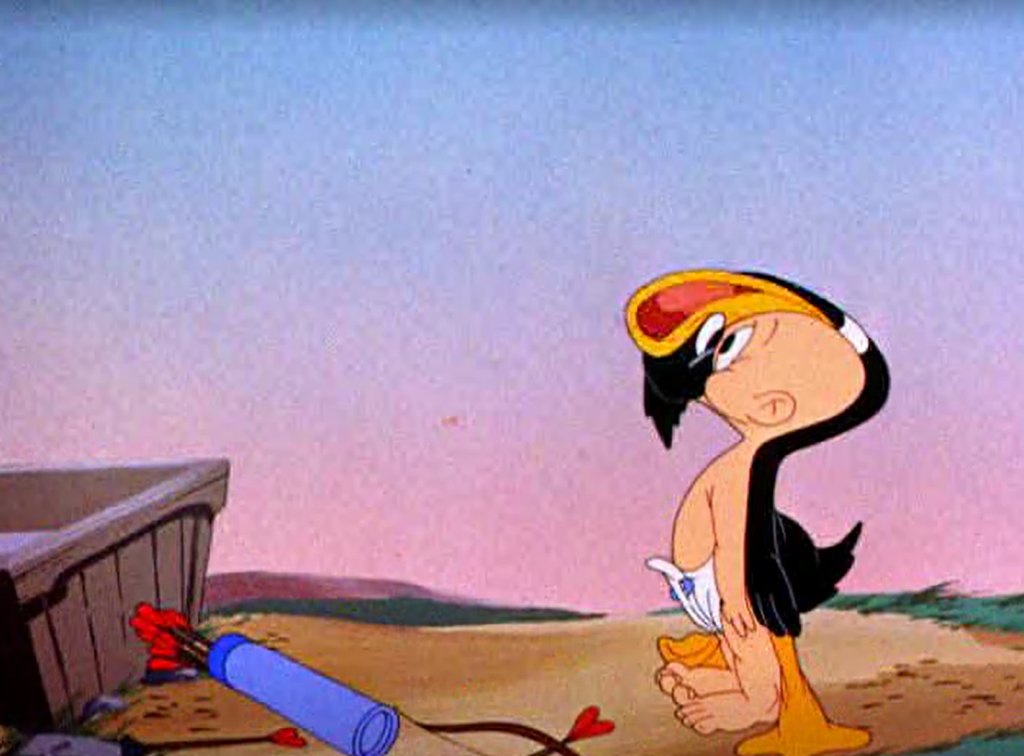
1945
Around 1944-1945 the Warner Bros cartoons looked remarkably better from before. Backgrounds were more lush and the animators have gotten enough practice at animating Bugs, Daffy & co, to catch up on Disney in terms of smoothness of animation. 1945 also heralded the debut of several new characters:
Looney Tunes – Odor-able Kitty, 1945
More Chuck Jones goodness and the first appearance of Pepe Le Pew, revealed to be an American skunk who fakes his French accent.
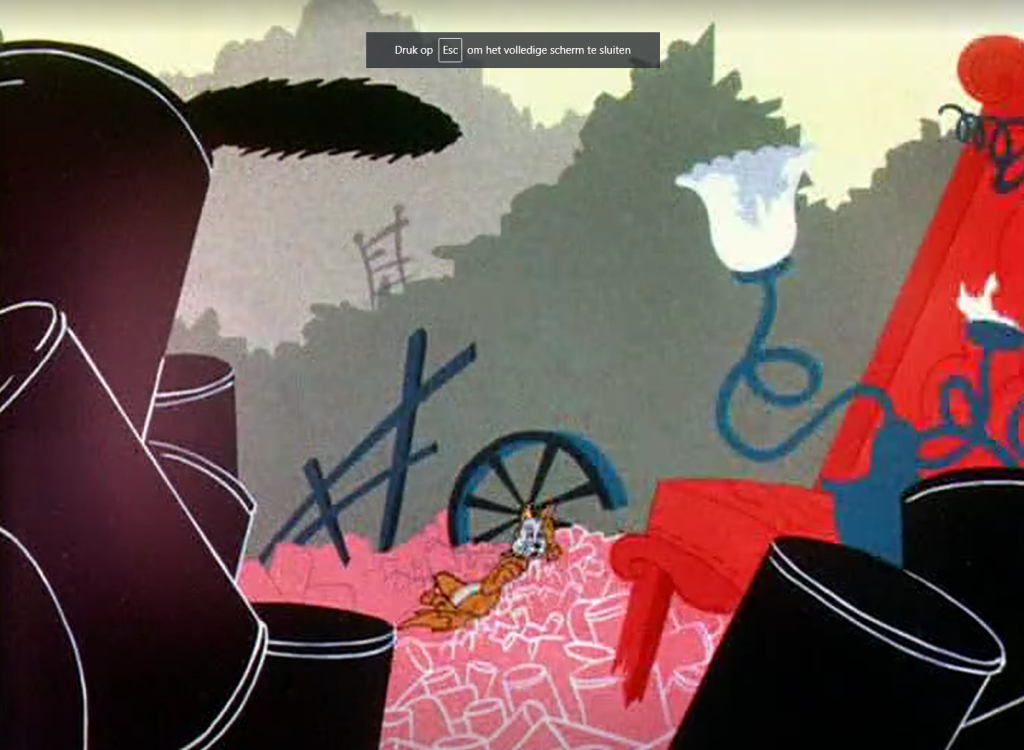
Merrie Melodies – Life With Feathers, 1945
First appearance of Sylvester the cat.
Merrie Melodies – Hare Trigger, 1945
First appearance of Yosemite Sam, who was created to give Bugs Bunny a tougher foe.
1946
Looney Tunes – Baby Bottleneck, 1946
Clampett’s squash-and-stretch animation, that helped set Warner Bros apart from Disney, takes on new levels in the second half of this cartoon.
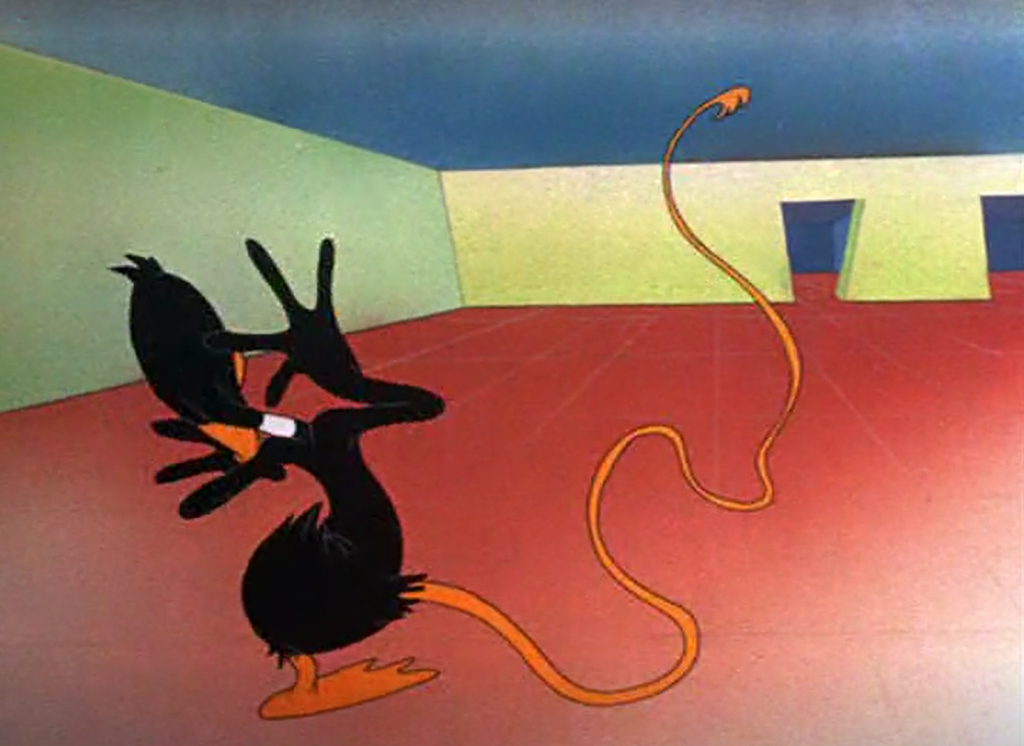
Looney Tunes – Kitty Kornered, 1946
I’ll have whatever Clampett’s having.
Looney Tunes – The Great Piggy Bank Robbery, 1946
Jon Kricfalusi called this one of the greatest things he’d ever seen. It’s not hard to see why. There’s incredible energy in this cartoon. The animation on Daffy alone in the first minutes is astounding. The film noir vibe and backgrounds remind me of Fleischer’s early Superman cartoons or 90’s Batman. The standalone paintings at 5:20, incredibly detailed close ups of characters, were a huge influence on Kricfalusi’s Ren & Stimpy which was an immediate influence on some well-known kids cartoons from a when I was a kid, like Spongebob Squarepants or Dexter’s Laboratory. My favorite moment is at 6:20 where Daffy gets squished in the door opening by all the other bodies and his body parts separate and wiggle themselves out to reassemble themselves a bit later. The Great Piggy Bank Robbery is without a doubt one of Clampett’s biggest achievements.
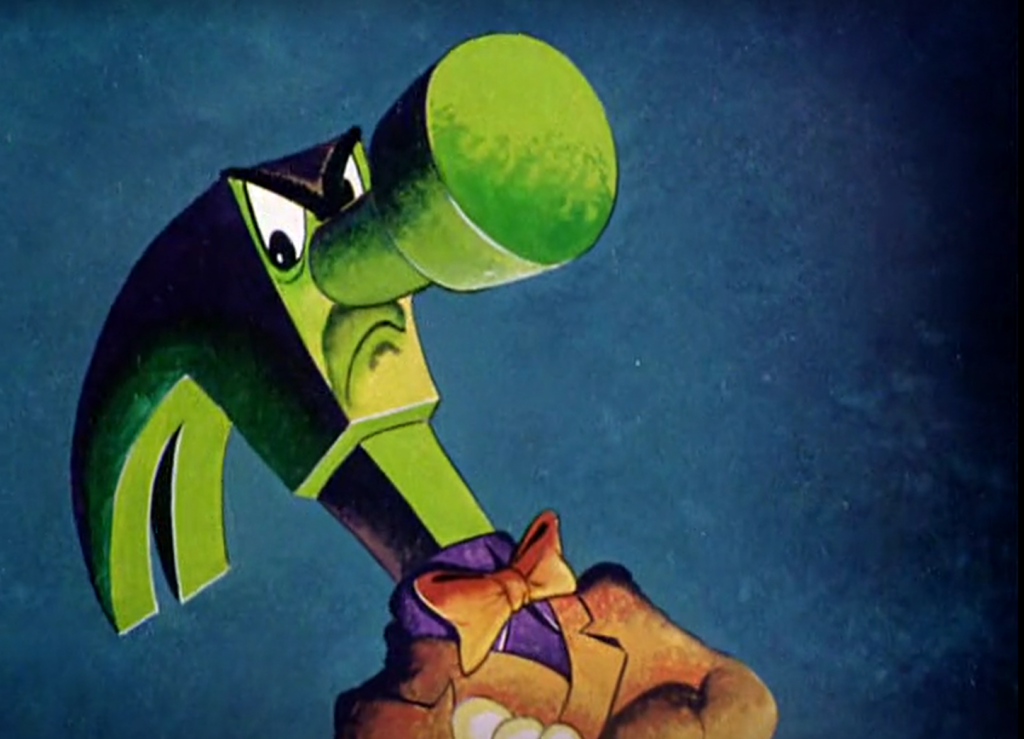
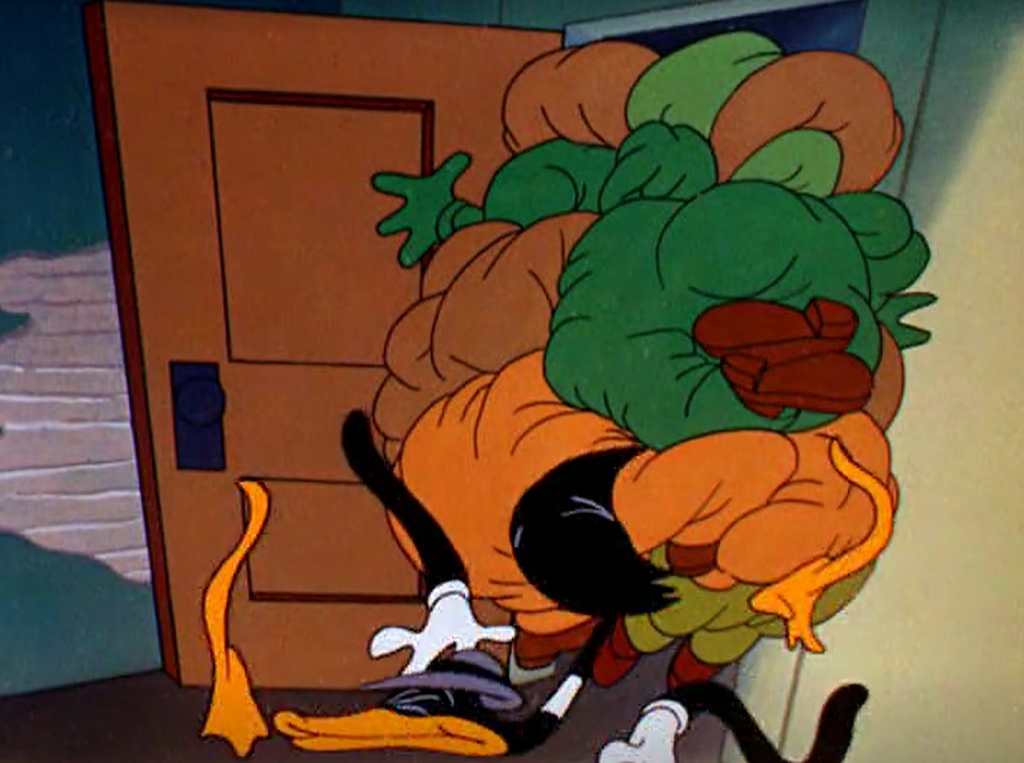
Looney Tunes – The Big Snooze, 1946
This was Clampett’s last cartoon at Warner Bros. The new boss was less tolerant of him than Schlesinger was and his style apparently became too divergent from the other directors. That’s right, the very style that Warner Bros owes its uniqueness too, got him fired. So one of the most regrettable decisions in the history of animation happened: Robert Clampett, who was at the peak of his creativity, left Warner Bros’ animation department. Clampett would go on to Screem Gems and a short run at Columbia, and would later win three Emmys with the puppet show Time for Beany. Not sure how I feel about that.
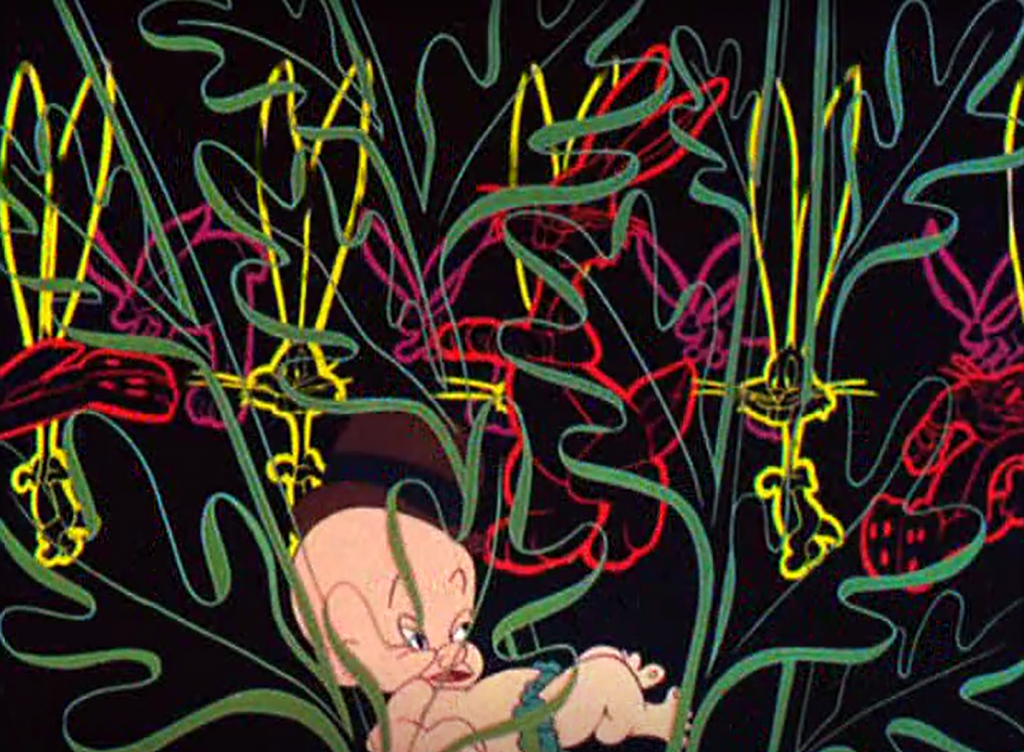
1947
Looney Tunes – Scent-imental over you, 1947
I wanna drink Chuck Jones’ backgrounds.
Merrie Melodies – Tweetie Pie, 1947
First pairing of Sylvester and Tweety. Deceptively normal, bit of a Tom and Jerry rip off. But really good and really funny. I would elaborate but I obviously lack the vocabulary. Ironically it broke Tom and Jerry’s winning streak at the Oscars. Best gag is at the end.
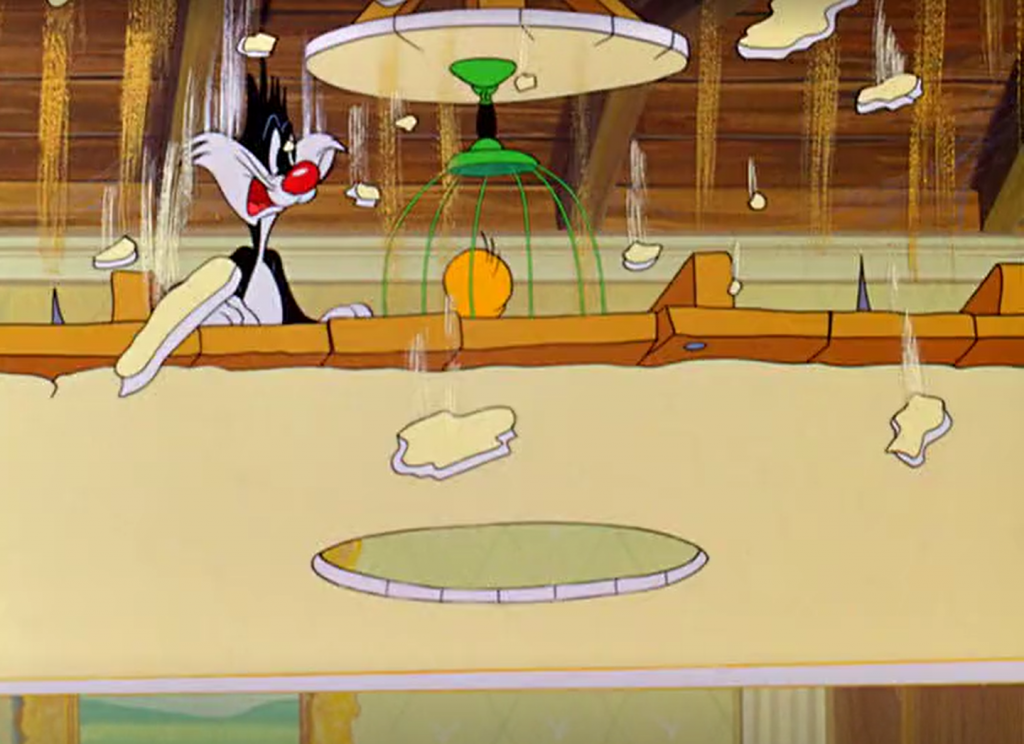
1948
Looney Tunes – Haredevil Hare, 1948
First cartoon with Marvin the Martian, a strange creature from outer space, for reasons unknown dressed in random medieval attire and sneakers.
Merrie Melodies – Dough Ray Me-ow, 1948
A cartoon completely carried by the stupidity and dumb luck of Heathcliff the fat cat. Laugh out loud funny!
Looney Tunes – Odor of the Day, 1948
Only a short part of the short, but a funny funny starring Pepe Le Pew in a battle of odors with a dog.
Looney Tunes – Daffy Dilly, 1948
Funny gags and one of those LT’s with randomly excessive attention to detail in the layouts.
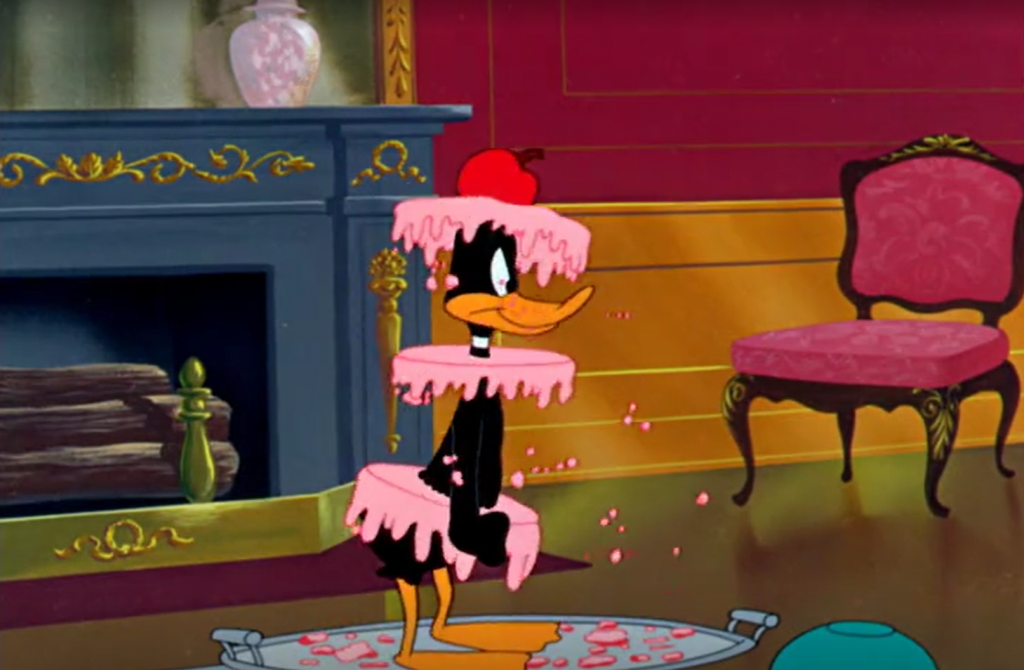
Merrie Melodies – Scaredy Cat, 1948
Good looking short, wacky animation. Elmer moves into a haunted house and Sylvester is so scared of ghosts he’d rather shoot himself in the head…? Anyway he’s rightly scared, these are some troublesome ghosts.
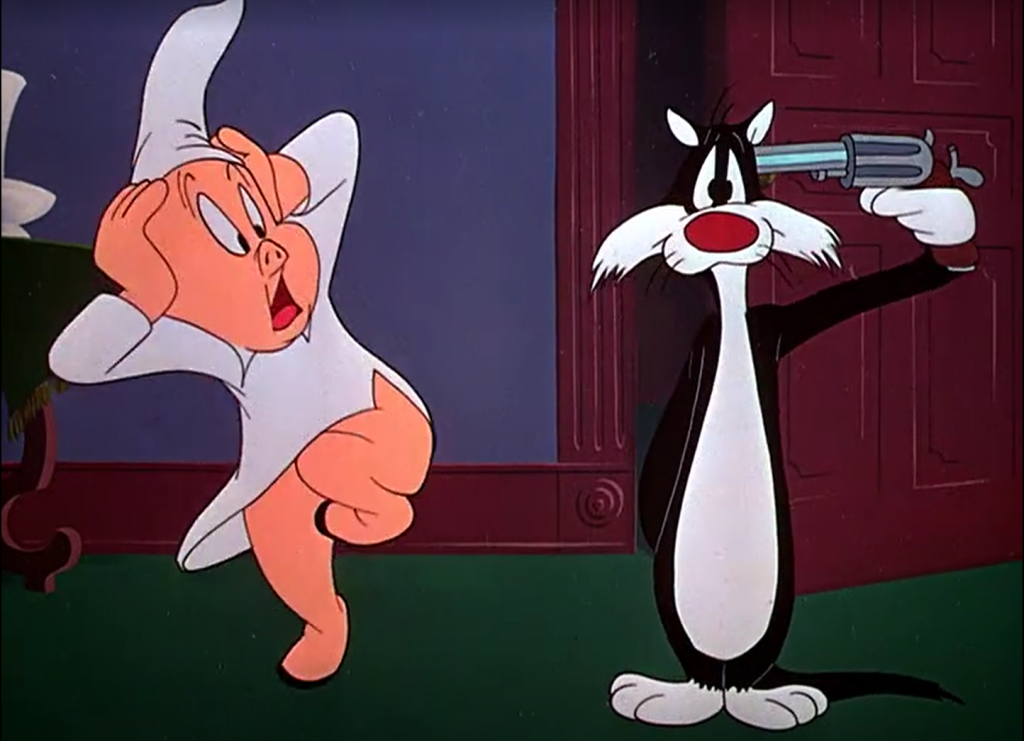
1949
Looney Tunes – Fast and Furry-ous, 1949
Introduction of the Road Runner and Wil E Coyote, arguably the perfection of the cat-and-mouse gimmick. Most of the gags is this first one are legendary.
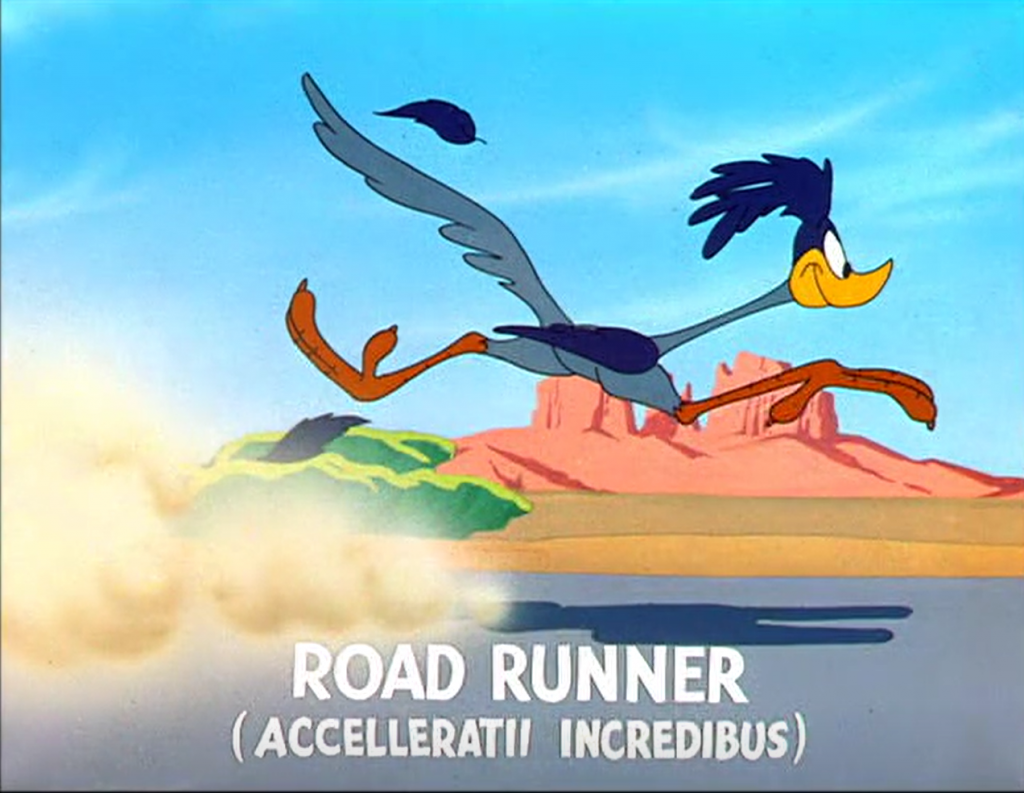
The Looney Tunes and Merrie Melodies have evolved into a kind of anti-Disney. Where Disney focuses on realistic animation, cute designs and occasionally fairytale-like abstraction, like in Fantasia, Warner Bros cartoons have more experimentation, goes to the outrageous and distorts the character’s shape more often. It’s interesting to see how all these studio make their own groundrules for what is possible in a cartoon and what isn’t. Another very clear distinction is the characters’ personalities. Where Mickey, Goofy, Donald and Pluto are all very innocent in their own heroic, oblivious, frustrated or animal ways, the Looney characters are the exact polar opposite. Bugs takes pleasure in teasing and torturing his hunters, Daffy is borderline insane and Tweety is an innocent-looking but sadistic bastard. Disney appeals to the audience’s good nature, Warner Bros to our animal urges, flaws and insanity. It makes for hilarious scenes but I can’t blame the Academy Award committee for not encouraging the producers with an Oscar, even though the animators deserved it.
That was a lengthy one. To anyone who made it to the end: go to sleep, you have work in the morning. Did I skip your favourite Porky? Let me know in the comments and you might actually be the first person ever to use this comment section.
Next up: Metro-Goldwyn-Mayer’s Tom & Jerry
Early stages of animation: 1920-1937 – The rise of cartoons
Disney’s Snow White and the Seven Dwarves (1937) – Golden Age of Animation
Disney’s Pinocchio (1940) – Golden Age of Animation
Disney’s Fantasia (1940) – Golden Age of Animation
Disney’s Dumbo (1941) vs. Bambi (1942) – Golden Age of animation
Disney Cartoons 1937-1940 – Golden Age of Animation
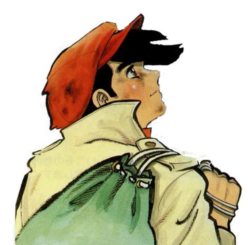
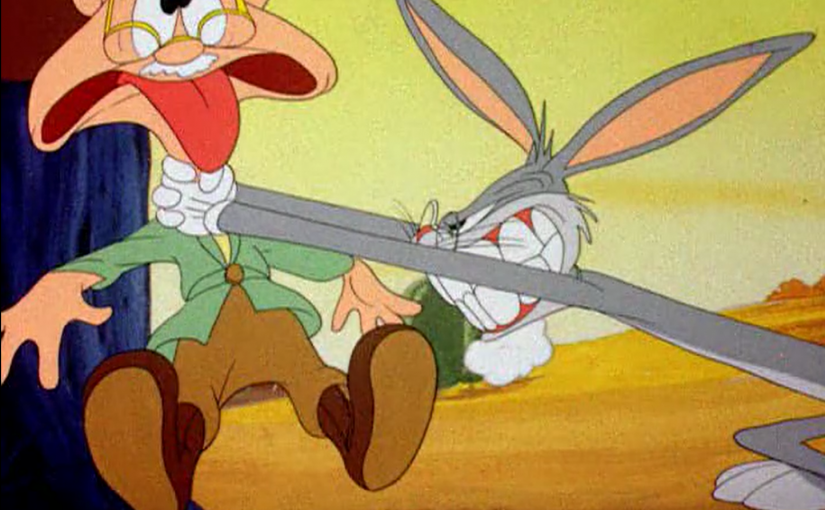
Bravo, I say! Very detailed as always, and yes, I watched all the clips, lol. Loved seeing the origins of everything, it’s what I live for :p
Again, thanks for the research and effort you put into ordering these works, much valued and appreciated!
Hi, thanks for the appreciation! I’m very glad to see my work is not in vain :p Hope to be able to find some time for a new post soon…
Thanks for the memories. There is a Looney Tunes cartoon which has a narrator voicing over scenes involving animals and characters. The scene I remember is the polar bear climbing up on a piece of floating ice and declaring to the narrator, “I don’t care what you say, bub, I’m cold.” Do you know this episode? I can’t find it. Thanks for this site. Excellent for those of us that love Bugs.
Hi, I’ve been terrible at following up comments, and i’m also afraid I have no clue about your question. Hope you found it in the meantime?